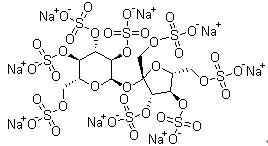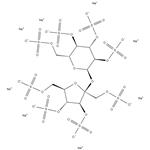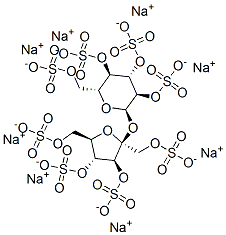The application of Sucrose octasulfate sodium salt in the digestive tract treatment

Sodium sucrose octasulfate is a chemical compound, and it has been used clinically for the prevention of gastrointestinal ulcers and was found to have cytoprotective effects. The sodium compounds are contents of various cosmetics for skin care and it was also evaluated in patients with cancer for the prevention and management of radiodermatitis [1].
Let see the application of sucrose octasulfate sodium salt in the digestive tract treatment as below. Aluminum sucrose octasulfate (SOS) is used clinically to prevent ulcers. Under physiologic conditions, the sodium salt of this drug can be formed. Some researchers used sodium as model chemical and studied whether sodium SOS was absorbed when administered orally. The study aimed to clarify how other polyanionic drugs, such as heparin and low molecular weight heparins, are absorbed [2]. SOS is a negatively charged polyanion, and its aluminum salt is insoluble, forming a gel in the gastrointestinal tract, and thus is believed not to be absorbed. Under physiologic conditions, however, aluminum ions can exchange with sodium ions to form the water-soluble sodium salt of SOS. Despite its high-water solubility, sodium SOS is also not believed to be absorbed from the gastrointestinal tract because of its highly charged nature. Researchers want to assess whether sodium SOS is orally bioavailable. Study results demonstrated that sodium SOS is absorbed oral administration, and the drug is absorbed throughout the entire gastrointestinal tract with considerable absorption taking place in the stomach. Once absorbed, the sodium SOS binds primarily to the endothelium, with a small amount freely circulating in the plasma. The study also supports the hypothesis that sulfated polyanions are absorbed following drug administration by the oral route, which is in contrast to the currently accepted view that polyanions are not bioavailable when administered orally. But the study results for sodium salt of SOS provide the possibility of the oral absorption of negative polyanions opens avenues for long term use when systemic effects are desired.
Niels Bukh also studied the sodium salt of sucrose octasulfate for the treatment and/or prevention of lesion or inflammation in the digestive tract [3], and he developed a method of treating and/or preventing lesion and/or inflammation of non-peptic ulcer naturally in the digestive tract. The method comprises administering to a patient in need thereof a therapeutically or prophylactically effective amount of a salt or complex of a sulfated sucrose, and currently preferred salts are sodium and potassium salts, especially the octasulfate salts, which are water-soluble at a neutral pH. For the application, the advantages of sodium sucrose octasulfate as used: (1) water-soluble even at pH less than 5.5; (2) the water-soluble properties make a much lower dose can be administered compared to the practical water-insoluble sucralfate. Accordingly, dose-related side effects can be reduced when using a water-soluble compound which per se is relatively atoxic.
Reference
[1] https://www.ons.org/node/4111?topic=1266
[2] Linda M. Hiebert etc., Tissue Distribution of [14C] Sucrose Octasulfate following Oral Administration to Rats, Pharmaceutical Research, Vol. 19, No. 6, June 2002, 838-844.
[3] Niels Bukh, Use of water-soluble sucroses for the treatment and/or prevention of lesion or inflammation in the digestive tract, WO1994000476A1.
You may like
Lastest Price from Sucrose octasulfate sodium salt manufacturers

US $5.00-2.00/kg2024-04-16
- CAS:
- 74135-10-7
- Min. Order:
- 1kg
- Purity:
- 99%
- Supply Ability:
- g-kg-tons, free sample is available

US $15.00-10.00/KG2021-07-13
- CAS:
- 74135-10-7
- Min. Order:
- 1KG
- Purity:
- 99%+ HPLC
- Supply Ability:
- Monthly supply of 1 ton


